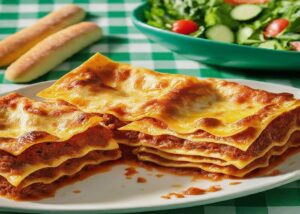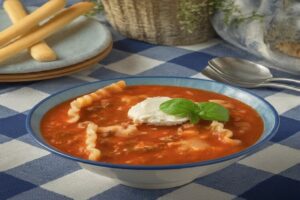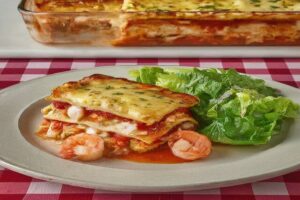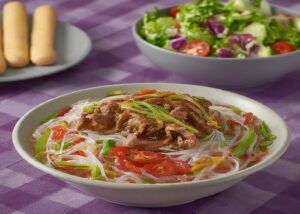Are you a pasta lover? Well, get ready to dive into the wonderful world of pasta!
In this comprehensive guide, we’ll be exploring what pasta is, different types of pasta, their unique shapes, fascinating origins, and the best pairings to make your taste buds dance with joy.
Pasta comes in countless shapes and sizes, each with its own distinct characteristics.
From long and thin spaghetti to short and tubular penne, we’ll take you on a journey through the vast array of pasta varieties out there.
You’ll learn about classics like fettuccine and rigatoni, as well as lesser-known gems like farfalle and orecchiette.
But it’s not just about the shapes! We’ll also delve into the intriguing origins of these pasta types.
Did you know that spaghetti originated in Italy or that macaroni has roots in ancient Greece?
Discovering the history behind your favourite pasta dishes adds an extra layer of appreciation for these culinary delights.
Of course, no guide to pasta would be complete without discussing the perfect pairings.
We’ll explore traditional sauces that complement specific types of pasta impeccably.
Whether it’s a creamy Alfredo sauce with fettuccine or a hearty Bolognese sauce with penne rigate, we’ve got you covered with mouthwatering suggestions that will take your pasta game to new heights.
So grab a fork and get ready for an adventure through the world of pasta.
By the end of this guide, you’ll be armed with knowledge about different types of pasta shapes, their origins, and which sauces bring out their flavours best. Let’s dig in!
[lwptoc]
A Comprehensive Guide to Different Types of Pasta: Exploring Shapes, Origins, and Best Pairings
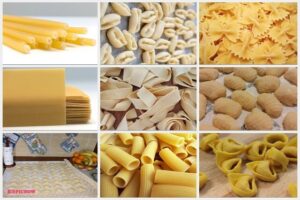 From spaghetti to lasagna, pasta comes in many shapes and sizes.
From spaghetti to lasagna, pasta comes in many shapes and sizes.
If you’re a self-proclaimed pasta lover, it’s essential to know the differences between various types.
With this detailed guide on understanding different types of pasta, you’ll be sure to impress your dinner guests at your next Italian-inspired meal.
What is Pasta
Pasta is a type of food typically made from an unleavened dough of wheat flour mixed with water or eggs, and formed into sheets or other shapes, then cooked by boiling or baking.
Rice flour, or legumes such as beans or lentils, are sometimes used in place of wheat flour to yield a different taste and texture, or as a gluten-free alternative. Pasta is a staple food of Italian cuisine.
Pasta is divided into two broad categories: dried (pasta secca) and fresh (pasta fresca).
- Dried pasta:
- Dried pasta is the most common type of pasta, and it is made by kneading a dough of wheat flour and water until it is smooth and elastic.
The dough is then extruded through a machine to create different shapes of pasta, such as spaghetti, macaroni, and penne.
Dried pasta is then dried for several hours or days until it is hard and brittle.
- Fresh pasta:
- Fresh pasta is made in a similar way to dried pasta, but it is not dried after it is extruded.
Instead, it is cooked immediately or stored in the refrigerator for a short period of time.Fresh pasta has a softer and more delicate texture than dried pasta.
Pasta is available in a wide variety of shapes and sizes.
Some of the most common shapes include spaghetti, macaroni, penne, and fettuccine. Pasta can also be filled with a variety of ingredients, such as meat, cheese, or vegetables.
Pasta is a versatile food that can be used to make a variety of dishes.
It can be served as a main course, side dish, or soup.
Pasta is also a popular ingredient in salads and casseroles.
The Fascinating World of Pasta and Its Many Varieties
Welcome to the fascinating world of pasta, where a simple combination of flour and water transforms into an array of delicious and versatile dishes.
From comforting classics to gourmet creations, pasta has captured the hearts and palates of people around the globe. In this section, we will explore the different types, shapes, and varieties of pasta types that make this culinary staple so diverse and exciting.
Pasta comes in various forms, each with its own unique characteristics.
Whether it’s long strands or short shapes, smooth or ridged textures, there is a pasta type to suit every taste and recipe. From spaghetti to penne, linguine to fusilli, the possibilities are endless.
The wide range of pasta shapes adds another layer of intrigue to this beloved food. Each shape not only affects the way sauce clings to it but also contributes to the overall dining experience. Whether you prefer tubes like rigatoni or twists like rotini, each shape brings its own charm and functionality to a dish.
Furthermore, exploring different varieties of pasta opens up a world of flavours and cultural traditions. From Italian classics like fettuccine Alfredo and lasagna to Asian favourites like soba noodles or rice vermicelli used in stir-fries and soups – there is something for everyone’s palate.
So join us as we delve into the captivating world of pasta types, shapes, varieties – unlocking new culinary possibilities along the way. Get ready for an exploration that will leave you craving your next bowlful!
What Are the Different Types, Shapes, and Varieties of Pasta?
Pasta comes in a wide variety of types, shapes, and varieties.
From spaghetti to penne, learn about the different types of pasta and how to use them in various dishes.
Long and Thin: Exploring Spaghetti, Linguine, and Fettuccine
Long and thin pasta shapes like spaghetti, linguine, and fettuccine have been beloved staples in Italian cuisine for centuries.
Each of these pasta varieties offers a unique texture and taste experience, making them popular choices for a wide range of dishes.
- Spaghetti;
- Vermicelli
 Vermicelli noodles are skinny and is a traditional type of pasta, similar to spaghetti strands.
Vermicelli noodles are skinny and is a traditional type of pasta, similar to spaghetti strands.
There’s both an Italian and an Asian vermicelli.
The Italian one is made with semolina and the Asian one is a rice noodle made from rice flour.The Asian rice noodle are often used in stir-fries such as Chop Suey, soups, spring rolls, and salads.
- Linguine;
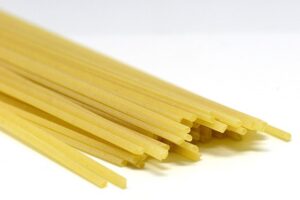 Linguine noodles are similar to spaghetti but are slightly wider and flatter.
Linguine noodles are similar to spaghetti but are slightly wider and flatter.
This shape provides a more substantial bite and allows for better sauce adherence.
Linguine pairs exceptionally well with lighter sauces like pesto or seafood-based preparations such as linguine alle vongole (linguine with clams).
- Fettuccine;
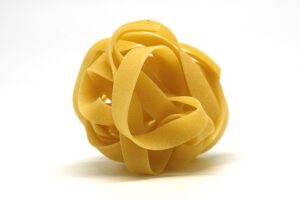 Fettuccine pasta stands out with its wide, ribbon-like shape.
Fettuccine pasta stands out with its wide, ribbon-like shape.
This flat noodle is often associated with rich and creamy sauces like Alfredo or carbonara due to its ability to hold these robust flavours.Fettuccine can also be used in dishes such as fettuccine primavera, where it acts as a base for showcasing vibrant vegetables.
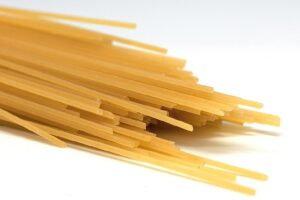 Spaghetti, perhaps the most well-known of the three, is characterized by its long, cylindrical shape. Its versatility allows it to be paired with a variety of sauces, from simple tomato-based ones to more complex meat or seafood concoctions.
Spaghetti, perhaps the most well-known of the three, is characterized by its long, cylindrical shape. Its versatility allows it to be paired with a variety of sauces, from simple tomato-based ones to more complex meat or seafood concoctions.
Spaghetti is also commonly used in classic dishes such as spaghetti carbonara and spaghetti aglio e olio.
Whether you’re craving a simple marinara sauce on your spaghetti or indulging in a decadent fettuccine Alfredo dish, these long and thin pasta shapes offer endless possibilities for culinary exploration.
Their ability to absorb flavours and provide satisfying textures makes them an essential component of Italian cuisine worldwide.
Tubes and Cylinders: Discovering Penne, Rigatoni, and Macaroni
When it comes to pasta, there is a wide variety of shapes and sizes to choose from.
In this section, we will explore the world of tube-shaped pastas, specifically bucatini, penne, rigatoni, and macaroni.
- Bucatini;
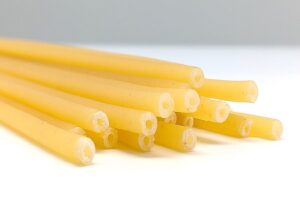 Bucatini is Italian for “hollow straws”.
Bucatini is Italian for “hollow straws”.
It looks a lot like traditional spaghetti, however, it’s more round, and is a little thicker than normal spaghetti.There’s a hole through the middle that gives each noodle a hollow centre, making it great for catching that little bit of extra sauce.
It is perfect when cooked in soups, pasta dishes, and casseroles.
Bucatini is often served with with pesto sauce, vegetables and parmesan or a pasta sauce like carbonara.- Penne;
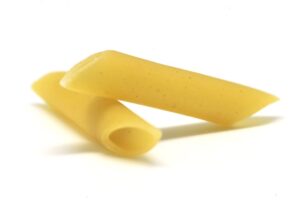 Penne pasta tubes are cylindrical in shape with diagonal cuts at both ends.
Penne pasta tubes are cylindrical in shape with diagonal cuts at both ends.
This design allows them to hold sauces and ingredients well, making them a popular choice for dishes like baked ziti and pasta salads.Their hollow center also ensures even cooking throughout.
- Rigatoni;
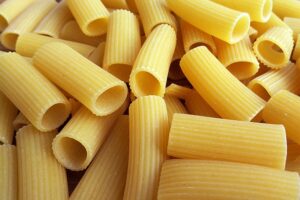 Rigatoni noodles are larger in size compared to penne.
Rigatoni noodles are larger in size compared to penne.
They have ridges on the outer surface which help to catch and hold onto sauces.Due to their sturdy nature, rigatoni is often used in hearty dishes like baked casseroles or served with chunky meat-based sauces.
- Macaroni;
 Macaroni shapes are shorter tubes that are curved or bent at an angle.
Macaroni shapes are shorter tubes that are curved or bent at an angle.
They come in various sizes such as elbow macaroni or large macaroni shells (also known as manicotti).Macaroni is commonly used in classic dishes like mac and cheese or pasta salads due to their ability to hold creamy sauces.
These tube-shaped pastas offer versatility in cooking as they can be paired with a wide range of ingredients and flavours.
Whether you’re looking for a comforting baked dish or a quick stovetop meal, penne, rigatoni, and macaroni provide delicious options that are sure to satisfy your pasta cravings.
Ribbons and Sheets: Unveiling Lasagna, Tagliatelle, and Pappardelle
lasagna sheets, tagliatelle ribbons, pappardelle noodles,ribbon-shaped pastas
Ribbon-shaped pastas, such as lasagna sheets, tagliatelle ribbons, and pappardelle noodles, are beloved by pasta enthusiasts for their wide and flat shape.
These pasta varieties offer a unique texture and versatility that make them perfect for a variety of dishes.
- Lasagna sheets;
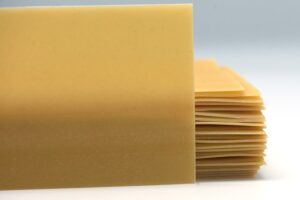 Lasagna sheets are large, rectangular pasta sheets that are commonly used in the classic Italian dish – lasagna.
Lasagna sheets are large, rectangular pasta sheets that are commonly used in the classic Italian dish – lasagna.
They provide a sturdy base for layering various ingredients like meat, cheese, and sauce.With their wide and flat shape, lasagna sheets create distinct layers that result in a satisfying bite.
- Tagliatelle;
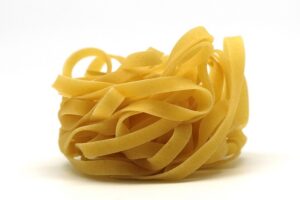 Tagliatelle ribbons are long, flat pasta strands that originated in Northern Italy.
Tagliatelle ribbons are long, flat pasta strands that originated in Northern Italy.
These delicate ribbons are typically wider than fettuccine but narrower than pappardelle.Tagliatelle is often served with rich sauces like ragu or carbonara. The broad surface area of tagliatelle allows it to hold onto the sauce beautifully while providing an enjoyable mouthfeel.
- Pappardelle;
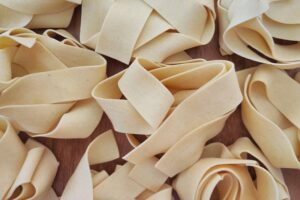 Pappardelle noodles are wide ribbon-shaped pastas known for their robust texture and ability to hold up well with hearty sauces.
Pappardelle noodles are wide ribbon-shaped pastas known for their robust texture and ability to hold up well with hearty sauces.
Originating from Tuscany, pappardelle is traditionally made with eggs and flour.Its width makes it perfect for capturing chunky meat or vegetable-based sauces.
These ribbon-shaped pastas offer endless possibilities when it comes to culinary creativity.
From traditional Italian recipes to innovative fusion dishes, lasagna sheets, tagliatelle ribbons, and pappardelle noodles bring a delightful twist to any meal they grace.
Shells and Spirals: Delving into Conchiglie (Shell), Fusilli (Corkscrew), and Rotini (Spiral)
Conchiglie, fusilli, and rotini are three popular types of pasta that stand out due to their unique shapes.
Conchiglie, also known as shell pasta, features a curved shape resembling seashells.
Fusilli, on the other hand, is characterised by its corkscrew-like spiral shape.
Lastly, rotini showcases a twisted and spiral design.
- Conchiglie;
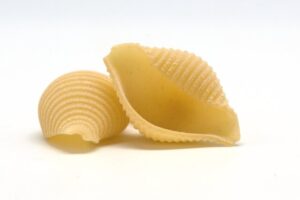 Conchiglie shells are not only visually appealing but also serve as perfect vessels for capturing sauces and flavours within their concave shape.
Conchiglie shells are not only visually appealing but also serve as perfect vessels for capturing sauces and flavours within their concave shape.
Their ridges and curves make them ideal for holding chunky sauces or ingredients like vegetables or meat.
- Fusilli;
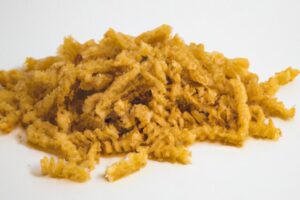 Fusilli’s corkscrew shape allows it to hold onto sauces exceptionally well.
Fusilli’s corkscrew shape allows it to hold onto sauces exceptionally well.
The spirals provide texture and help distribute the sauce evenly throughout each bite.This type of pasta is versatile and pairs well with a variety of sauces, from simple tomato-based ones to creamy Alfredo or pesto.
- Rotini;
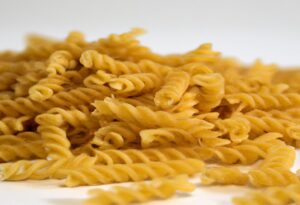 Rotini’s twisted spiral design makes it an excellent choice for hearty dishes as it can hold up against robust flavours and dense ingredients.
Rotini’s twisted spiral design makes it an excellent choice for hearty dishes as it can hold up against robust flavours and dense ingredients.
Its unique shape also helps to trap small bits of sauce or seasoning within its crevices, providing bursts of flavour in every mouthful.
All three types of pasta – conchiglie shells, fusilli corkscrews, and rotini spirals – offer not only a delightful visual appeal but also enhance the overall dining experience by creating interesting textures and enhancing the flavour profiles of various dishes they are used in.
Filled Delights: Indulging in Ravioli,Tortellini,and Cannelloni
When it comes to pasta dishes, there are few that can rival the satisfaction of biting into a perfectly cooked piece of filled pasta.
Ravioli, tortellini, and cannelloni are all examples of stuffed pastas that have gained popularity for their delicious fillings and unique flavours.
- Ravioli;
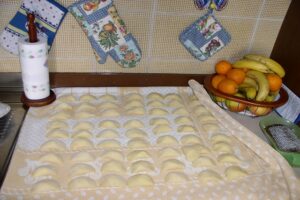 Ravioli, with its square or round shape, is often filled with a variety of ingredients.
Ravioli, with its square or round shape, is often filled with a variety of ingredients.
From classic cheese fillings like ricotta or mozzarella to more adventurous options like spinach and mushroom or butternut squash, ravioli offers a world of possibilities when it comes to fillings.
- Tortellini;
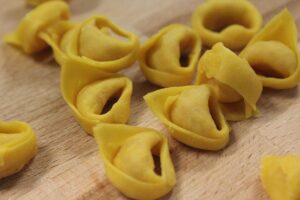 Tortellini, on the other hand, is known for its distinctive ring shape.
Tortellini, on the other hand, is known for its distinctive ring shape.
Traditionally filled with a mixture of meat such as pork or beef along with cheese and herbs, tortellini has become a staple in Italian cuisine.
Nowadays, you can find tortellini filled with everything from prosciutto and Parmesan to spinach and feta.- Cannelloni;
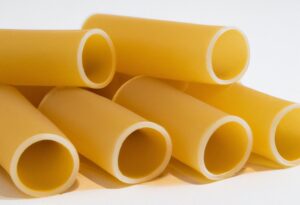 Cannelloni takes the concept of stuffed pasta to another level by using large tubes instead of individual pieces.
Cannelloni takes the concept of stuffed pasta to another level by using large tubes instead of individual pieces.
These tubes are typically filled with a rich mixture of meats such as ground beef or sausage combined with cheese and herbs.
For those looking for a vegetarian option, cannelloni can also be filled with delicious combinations like spinach and ricotta or roasted vegetables.
Filled pastas offer endless possibilities for creating flavourful dishes.
Whether you prefer classic combinations or more innovative fillings, ravioli, tortellini, and cannelloni provide an indulgent experience that is sure to satisfy any pasta lover’s cravings.
So go ahead and explore the world of stuffed pastas – your taste buds will thank you!
Dumpling Pasta: The unique textures of gnocchi and gnudi
Pasta dumplings are a type of pasta that is shaped into small, round balls or dumplings.
They are typically made with a dough that is softer and more moist than traditional pasta dough, and they are often filled with a variety of ingredients, such as meat, cheese, vegetables, or sweet fillings.
- Potato Gnocchi;
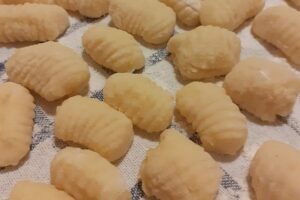 Gnocchi is a type of pasta, but it is typically categorised as a dumpling.
Gnocchi is a type of pasta, but it is typically categorised as a dumpling.
This is because it is made with a dough that is softer and more moist than traditional pasta dough, and it is often shaped into small, round balls or dumplings.
Gnocchi is also typically made with potatoes or ricotta and flour as a main ingredient, which gives it a unique texture and flavour.
Common accompaniments of gnocchi can include something simple such as melted butter with sage or pesto.
A cream base sauce or a traditional Carbonara are both great, because of the larger surface area of the dumpling there’s plenty for your sauce to stick to.- Gnudi;
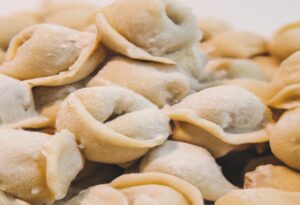 Gnudi are similar to gnocchi, but they are made with less flour and more ricotta cheese.
Gnudi are similar to gnocchi, but they are made with less flour and more ricotta cheese.
This gives them a lighter and fluffier texture.
Gnudi are often served with a simple tomato sauce or butter and sage.
Pasta dumplings are a delicious and versatile food that can be enjoyed by people of all ages and cultures.
They are a great option for a quick and easy meal, or for a special occasion.
Pasta Origins Around the World: From Italy to Asia and Beyond
Pasta is a beloved dish enjoyed by people all over the world.
While it is often associated with Italian cuisine, pasta has diverse origins that span across different countries and continents.
In this section, we will explore the rich history and variety of pasta from Italy to Asia and beyond.
- Italian pasta;
- Italian pasta is renowned for its wide range of shapes and textures. From spaghetti to penne, lasagna to ravioli, each type of pasta has its own unique characteristics that contribute to the overall culinary experience.
Italy has a long-standing tradition of pasta-making, with regional variations that showcase local ingredients and cooking techniques.
- Asian noodles;
- Moving beyond Italy, Asian countries have their own versions of noodles that are distinct in flavour and preparation methods.
Asian noodles come in various forms such as rice noodles, wheat noodles, or even mung bean noodles.Chinese cuisine offers a wide array of noodle dishes like chow mein and lo mein, while Japanese cuisine features udon and soba noodles in hearty soups or stir-fried dishes.
- Greek pasta;
- Pasta has also made its way into the culinary traditions of other countries around the world.
In Greece, for example, orzo is a popular type of pasta used in traditional dishes like pastitsio or served as a side dish alongside grilled meats.
- South Americian noodles;
- In South America, countries like Argentina have embraced Italian influences with their own spin on pasta dishes such as fideos (thin noodles) cooked in flavourful broths.
The international appeal of pasta can be seen in fusion dishes where different cultural influences blend together harmoniously.
For instance, Thai-inspired peanut sauce can be paired with spaghetti for a unique twist on traditional Italian flavours.
Best Pairings: Matching Pasta Shapes with Sauces and Ingredients
When it comes to pasta, the sauce you choose can make all the difference in creating a delicious and satisfying meal.
Each pasta shape has its own unique texture and characteristics, which can be enhanced by pairing it with the right sauce and ingredients.
In this section, we will explore some of the best pairings for matching pasta shapes with sauces and ingredients.
Choosing the perfect sauce for your pasta is not just about personal preference; it’s also about understanding how different sauces complement specific types of pasta.
For example, long, thin pastas like spaghetti or linguine are best paired with light, delicate sauces such as aglio e olio or marinara.
The smooth texture of these sauces coats the strands of pasta evenly, allowing for a harmonious blend of flavours.
On the other hand, robust and chunky sauces like Bolognese or ragù are better suited for thicker pastas like penne or rigatoni.
The ridges and hollows in these shapes help to capture and hold onto the hearty sauce, resulting in a more satisfying bite.
Other classic pairings include pairing creamy Alfredo sauce with fettuccine or pairing pesto sauce with fusilli or farfalle.
These combinations showcase how certain flavours and textures work together to create a harmonious dish.
It’s important to note that while there are traditional pairings that have stood the test of time, there is also room for experimentation and creativity when it comes to matching pasta shapes with sauces.
Ultimately, it’s about finding combinations that you enjoy and that bring out the best in both the pasta and the sauce.
In this section, we will delve into specific pasta recipes and their ideal sauce pairings.
Whether you’re a seasoned cook looking for new inspiration or a beginner wanting to learn more about creating delicious pasta dishes, these recipes using various pasta shapes will provide you with valuable insights on how to match different types of pastas with their perfect sauces.
Conclusion: Exploring the World of Pasta is a Never-Ending Adventure
In conclusion, exploring the world of pasta is truly a never-ending adventure.
This culinary delight offers an incredible variety of shapes, sizes, and flavours that cater to every palate.
From classic Italian dishes like spaghetti and lasagna to lesser-known regional specialties like orecchiette and strozzapreti, there is always something new to discover.
Beyond its delicious taste, pasta also holds great cultural significance.
It has become a staple in cuisines around the world and is often associated with family gatherings and festive occasions.
The art of making pasta by hand has been passed down through generations as a cherished tradition.
Whether you are a seasoned pasta lover or just beginning to explore its wonders, there is no doubt that this versatile ingredient will continue to captivate our taste buds for years to come.
So go ahead and embark on your own pasta adventure – try new recipes, experiment with different sauces and toppings, and savour the rich history and flavours that this beloved dish has to offer.
« Cooking Definitions
